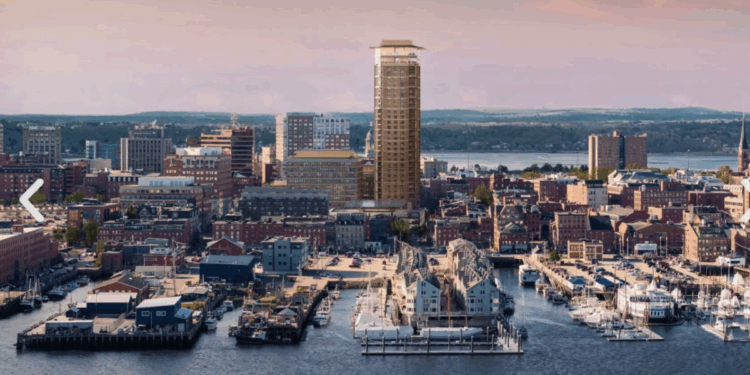Portland may soon be home to the tallest building in Maine, outpacing the current tallest, Saint Joseph’s Church in Biddeford, by almost 150 feet. A proposed 30-story tower in the Old Port would bring hundreds of new housing units, commercial space, and mixed-use vitality to the city’s downtown. Furthermore, this project is a product of ReCode Portland, the city’s long-overdue overhaul of its zoning and land use code.
The tower demonstrates how regulatory reform can pave the way for increased development and investment. But it also reveals how limited ReCode’s scope really was. If Portland is serious about tackling its housing shortage, this project should be treated as the beginning of reform, not the end.
How ReCode Made the Tower Possible
For decades, Portland’s land use rules stifled growth, capped heights, and made it nearly impossible for larger-scale housing projects to move forward. Its zoning code was around a thousand pages long, making it almost impossible for developers to navigate. ReCode, adopted near the end of 2024, changed that.
Notably, ReCode raised maximum building heights in central district blocks, in some cases from around 220 feet to as high as 380 feet. The new tower proposal plans to take full advantage of this regulatory change, rising far above what was once legally possible.
ReCode also loosened restrictions on mixed-use zoning and reduced costly parking requirements. The developer’s proposal does not include additional off-street parking, something that would have been a non-starter under the old rules. These reforms made the tower feasible. In short, without ReCode, this project would not be possible.
Why the Tower Matters
Portland and Maine face a severe housing crisis. Vacancy rates are low, rents are rising, and new construction has struggled to keep pace with demand. Large projects like this tower matter because:
- Scale matters: A single tower can deliver more units than years of piecemeal construction.
- Location matters: Building in the urban core reduces sprawl, supports transit, and keeps more workers close to jobs.
- Momentum matters: A pioneering new project can normalize height and density, making future developments politically easier to achieve.
This tower, if built, would not solve the housing crisis alone. But it would be a visible step in the right direction, demonstrating that Portland can make its way out of scarcity, if the rules allow it.
The Limits of ReCode
As important as this project is, it also highlights the limitations of Portland’s reforms. ReCode raised height limits downtown, but most of the city is still subject to restrictive zoning. Single-family zoning dominance remains intact across vast swaths of land, and many neighborhoods remain effectively off-limits to new housing, even after state-imposed reforms from LD 2003.
Other barriers remain:
- Lengthy permitting processes and political review slow projects and raise costs.
- Impact fees and development charges are typically levied on new construction.
- Height and density reforms did not extend evenly across the city.
- Rent Control, Short-term Rental Restrictions, and Inclusionary Zoning all reduce the incentives to develop new housing.
The lesson is not that ReCode failed, but that it was a good first step. If Portland wants more towers and more mid-scale projects in other neighborhoods, it must do more.
NIMBY Concerns and the Real Path Forward
Of course, some Portlanders have raised concerns about the tower’s size, its impact on views, or whether it will “fit” the city’s character. However, housing scarcity cannot be solved while maintaining the perfect preservation of skyline aesthetics.
The alternative to building up is building out, which involves sprawling into surrounding towns, resulting in longer commutes and even higher housing costs. Portland’s choice is simple: either accept density downtown or push growth outward, making housing even less affordable.
The tower should be seen as a test case: if it succeeds, Portland should encourage this scale of development rather than treating it as an exception.
Beyond ReCode: What Comes Next
Maine Policy Institute believes projects like this tower point the way forward. But we should not wait for developers to push against the limits of reform. Instead, policymakers should:
- Expand zoning reform citywide: Apply ReCode’s lessons beyond the downtown core. Raise heights and allow more units in transit-accessible neighborhoods.
- Streamline approvals: Guarantee by-right permitting for projects that meet code, cutting down delays that drive up costs.
- Reduce unnecessary fees: Scale back development charges that make new housing less viable.
- Encourage density near jobs and services: Prioritize growth where infrastructure already exists.
Other Maine cities should take note. Portland’s new tower shouldn’t be only a Portland story; it’s a state story. Every municipality facing rising rents should look at how zoning reform unlocked this project and ask itself: Why not us?
A Crisis Too Big for Half-Measures
This tower is a victory for housing abundance, but it should not be an anomaly. Portland needs thousands of new units, not just one ambitious project. ReCode proved that rules matter. It gave Portland a glimpse of what’s possible.But if city leaders stop here, the housing crisis will deepen. Maine cannot afford to treat bold housing reform as a one-time experiment. However, with recent actions by Portland, such as the denial of the Live Nation venue, we’ll see how long the new tower proposal lasts.
Image: Renderings of proposed 380-foot tower at 45 Union Street Courtesy of Safdie Architects.










